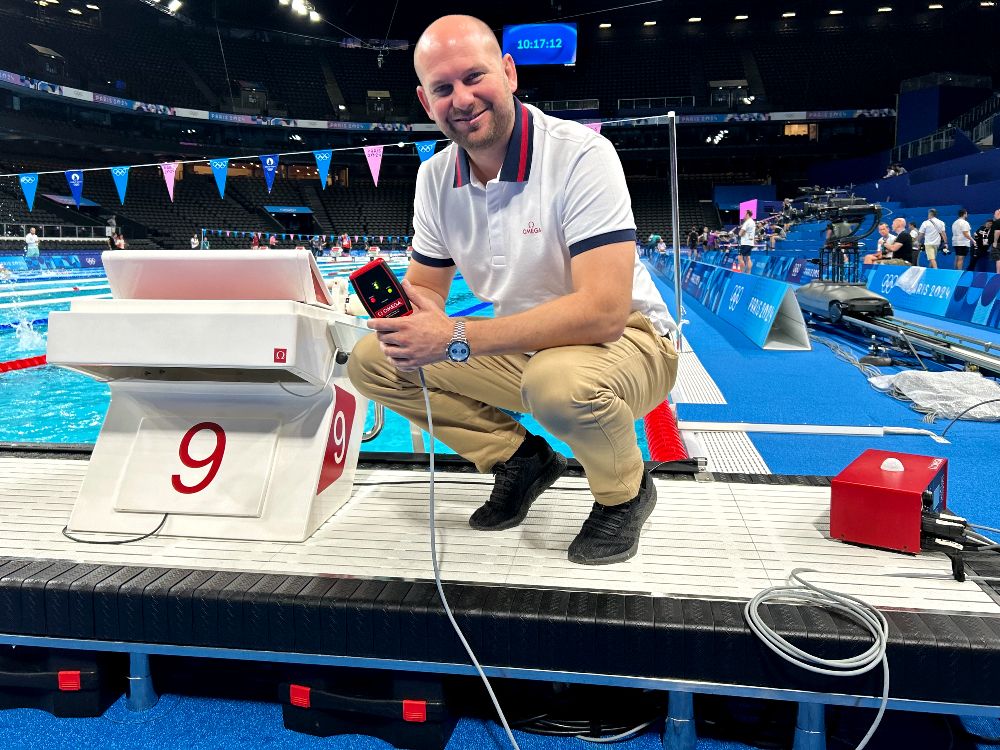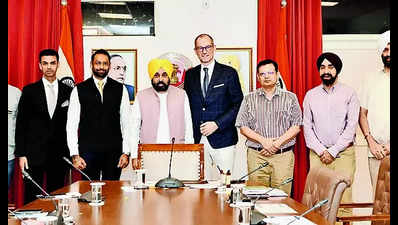PARIS — The moment an Olympic athlete begins competition their every move is being watched, analyzed and broadcast. Whether they are running, jumping, throwing, swimming, serving, cycling or spinning, a combination of sensor technology and computer vision translates athletes’ movements into data, helping judges and audiences make sense of critical moments that can happen within fractions of seconds. OMEGA, best known as the Swiss luxury watchmaker, is also the official timekeeper of the Olympic and Paralympic Games and has descended on Paris with 550 staff members and 350 tonnes of equipment to play a hand in every sport in the program.
While each Olympics sees advancements in the timing and visualization technology used, OMEGA CEO Alain Zobrist says it is not yet at a point where it can replace human judges overseeing subjectively scored sports such as gymnastics and diving. “I don’t want to predict anything,” he said from the timekeeping room at the Paris La Défense Arena, where swimming events will be held. “It will depend on how the rules of the federations will evolve.

For now, we are using the technologies to be the support systems for the judges. It may take a little while for the technology to become a little bit more mature, for judges to feel a little bit more comfortable with it. It’s always a rather long process.
It took 20 years for manual timekeeping to be replaced with electronic timekeeping — so it will take about the same time frame for that as well.” For now, here are some of timing, visualization and related technologies being used at the Olympics. In both track and swimming events, starting blocks don’t just give athletes a strong start, they also ensure an equal playing field and are sources of data.
Each block has a built-in speaker, which is connected to electronic starting pistols, ensuring all athletes hear the starting gun at the same time. In track, starting block sensors measure an athlete’s force against the footrest and send data to an on-site computer so false starts can be detected. Per World Athletics, any reaction time faster than a tenth of a second is a false start.
In swimming, starting blocks measure release pressure and reaction time. These quartz-driven devices can give readings accurate to one millionth of a second, though this is calibrated for each sport. For some events, such precise measurements are inappropriate.
Swimming, for instance, is measured to one hundredth of a second, the equivalent of someone reaching the wall by the tip of a fingernail. Increased precision in timing is not appropriate because of tiny architectural variations in the length of lanes. “It would be unfair to athletes to measure in thousandths of a second,” Zobrist says.
In many events, single- or multi-camera systems can collect reams of data without the need for athletes to wear sensors. These cameras feed artificial intelligence models specifically trained for a given sport. For floor routines in gymnastics, this can show whether athletes left the allowed area, as well as the height and airtime of jumps and the angles of their feet, providing valuable information to judges.
In diving, data is collected on airtime and speed into the water, which again helps judges make decisions on the strength of a performance. The cameras also report the distance between the athlete and the board; athletes who fail to maintain a minimum safe distance from the board during a routine receive deduction points — something judges once had to determine by best estimation. Computer vision is how commentators can tell audiences how much distance athletes cover, how high they jump or how fast balls fly.
Athletes in some events — including athletics, triathlon and marathon swimming — wear sensors which transmit live information on speed and position (for sports like canoe, kayak and sailing the sensors are on the craft). These sensors allow real-time information about speed and position to be relayed to broadcasters, spectators and coaches. In athletics, the sensors are about the size of a credit card and part of the athletes’ paper bibs which, despite all advancements in technology, are fastened to athletes’ racing clothes with safety pins.
“It’s not because of the sensors that they’re still using bibs,” Zobrist says. Rules about bibs in athletics are dictated by World Athletics, which requires that athletes must wear bibs with identifying information such as their name. There are two Olympic sports where athletes need to stop the clock themselves: swimming and speed climbing.
This is done by hitting touchpads at the end of the event. Touchpads in swimming made their Olympic debut at the 1968 Mexico City Games. Before that, three judges with stopwatches monitored each lane with the average of their three readings making up the official time.
The touchpads are sensitive, but not so sensitive that they are triggered by the waves swimmers generate. Athletes need to exert a pressure between 1.5 and 2.
5 kg (3.3 and 5.5 pounds) on the pads.
When sport climbing debuted at the 2020 Tokyo Games, touchpads were also used for the event. Winners of track and cycling events don’t break the tape — rather their victory is marked when they pass through the beams of a photocell technology system, which instantly records their winning time. Photo-finish cameras at these games have higher resolution than ever before, capturing up to 40,000 photos per second on the finish line.
.


















